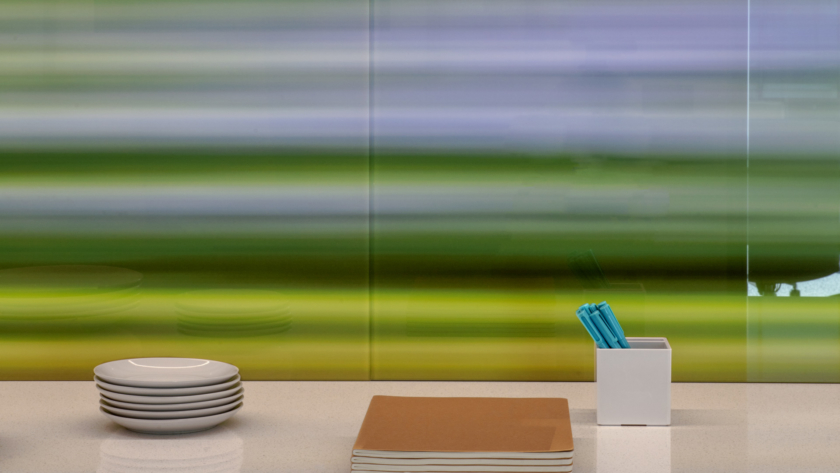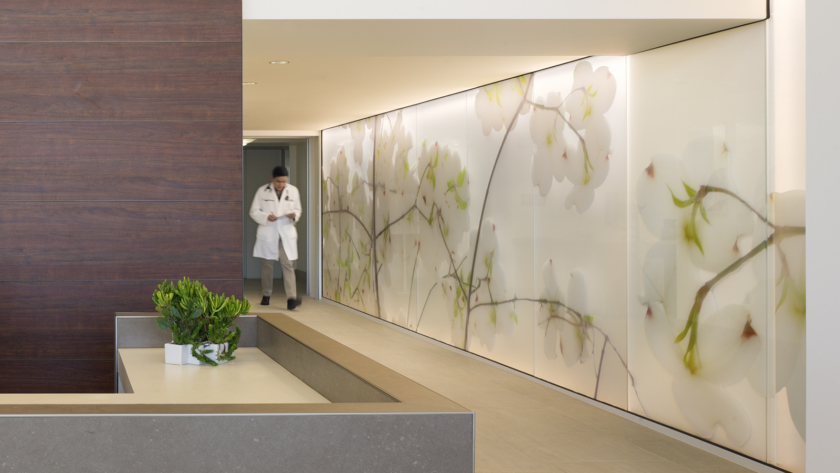Maintaining focus and attention is crucial for optimal performance in lab environments. However, the finite cognitive resource known as “directed attention” can become depleted, leading to cognitive difficulties, poor decision-making, and performance variability (Linden et al., 2005; Ohly et al., 2016). To combat this phenomenon, attention restoration theory (ART) has gained momentum, suggesting that exposure to natural environments can help overcome directed attention fatigue, also known as DAF (Kaplan, 2005). Skyline Design, renowned for its innovative glass solutions, offers a compelling way to create restorative lab spaces through its nature-inspired glass patterns.
Skyline Design understands the significance of incorporating restorative elements into lab environments. That’s why they have collaborated with acclaimed artists Henry Domke and Bonnie Edelman to create glass patterns that draw inspiration from the beauty of the natural world. These patterns seamlessly integrate with lab architecture, offering a unique and visually captivating solution.

“According to ART, a major goal of creating a restorative environment is to create scenes that encourage “soft fascination”, a cognitive state where one’s attention is held by the scene that they are taking in, but in a way that still permits reflection and the ability to address lingering, unresolved thoughts.”
— Basu, Duvall, & Kaplan, 2019
Encouraging “Soft Fascination”
One of the key principles of ART is to encourage “soft fascination,” a cognitive state where attention is captured by a scene without overwhelming it. Skyline Design’s glass patterns achieve just that. By emulating the richness and serenity of natural landscapes, these patterns create scenes that hold attention while still allowing for reflection and addressing unresolved thoughts. The result is a harmonious and restorative environment conducive to maintaining focus and recharging cognitive resources (Basu et al., 2019).
Enhancing Directed Attention
As lab techs’ or researchers’ gazes wander across the intricate designs inspired by serene forests, soothing seascapes, or vibrant floral motifs, they become immersed in a state of soft fascination. The subtle play of light and color within the glass panels captivates their attention without overwhelming it. Gradually, they feel a sense of calmness, focus, and mental rejuvenation overcoming any directed attention fatigue they may have been experiencing.

Creating an Ideal Lab Setting
By incorporating Skyline Design’s nature-inspired glass patterns, labs can cultivate an environment that seamlessly bridges the gap between nature and science. The captivating aesthetics of these patterns not only stimulate visual interest but also promote a connection to the natural world, regardless of the lab’s physical location. This integration has the potential to enhance attentional focus, encourage reflection, and contribute to a more balanced and productive work environment for researchers and scientists.
In the pursuit of scientific breakthroughs, the ability to maintain directed attention is paramount. Skyline Design’s nature-inspired glass patterns offer an innovative solution to combat directed attention fatigue and create restorative lab spaces. With their captivating designs, these patterns foster “soft fascination” and provide a visual connection to the natural world, promoting a harmonious and rejuvenating environment for lab technicians and researchers.
References
Basu, A., Duvall, J., Kaplan, R. (2019). Attention restoration theory: exploring the role of soft fascination and mental bandwidth. Environ. Behav. 51, 1055-1081. doi: 10.1177/0013916518774400
Kaplan, S. (1995). The restorative benefits of nature: toward an integrative framework. J. Environ. Psychol. 15, 169-182. doi: 10.1016/0272-4944(95)90001-2
Linden, D. V., Keijsers, G. P., Eling, P., and Schaijk, R. V. (2005). Work stress and attentional difficulties: an initial study on burnout and cognitive failures. Work & Stress 19, 23-26. doi: 10.1080/02678370500065275


